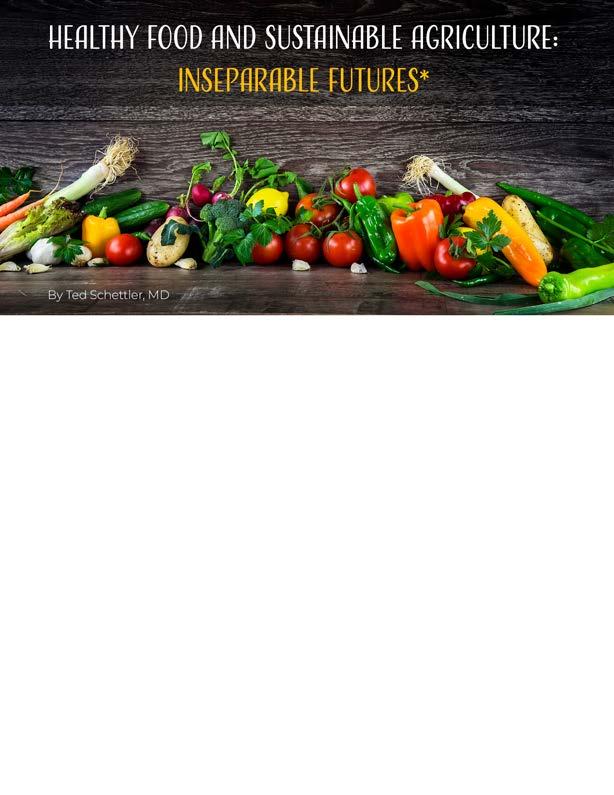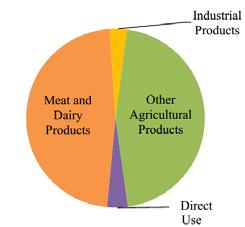
8 minute read
Healthy Food Sustainable Agriculture
© Can Stock Photo / okanakdeniz
Reviews of the Federal 2020-2025 Dietary Guidelines for Americans were mixed. Nutritionists welcomed recommended limits on added sugars, sodium, and saturated fat combined with emphasis on healthy fats and overall eating patterns rich in fruits, vegetables, and whole grains. The guidelines recommended relatively lower consumption of red and processed meats, sugar-sweetened foods and beverages, and refined grains. But once again, any mention of the sustainability of food production, a major part of an earlier advisory committee analysis, was left out. Critics denounced the politics behind the omission.
Advertisement
USDA Dietary Advisory Committee Guidelines: Sustainability is Critical
The 2015-2020 guideline advisory committee said that sustainability plays a critical role in meeting current and future nutrition needs. Promoting healthy dietary patterns that are produced more sustainably will conserve resources for present and future generations and help ensure long-term food security. But Big Agriculture would have none of it, lobbying successfully to reject considerations of sustainability in Federal dietary guidelines.
Big Ag Lobbied to Reject Sustainability in Final Guidelines
Big Ag’s program of high-input large-scale monocultures and crowded factory-like animal farms that produce abundant cheap calories often of poor nutritional value while putting workers and communities at risk, degrading soil, and fouling air and water with noxious pollutants and greenhouse gases is threatened by a sustainability goal. But a diverse and growing food movement in the US and abroad has different ideas. At its core it embraces the need to address the sustainability and resilience of food systems, as well as just and equitable access to healthy food, as essential to protect public and planetary health using approaches shaped by local circumstances.
The dominant agricultural system in the US relies on government support and public acceptance of externalized costs of pollution, loss of biodiversity, and ecosystem degradation. It is based on assumptions of climate stability, reliable water sources, and cheap energy. Structural vulnerabilities of the entire enterprise are increasingly obvious.
Big Ag’s Model: Adverse Impacts and Risks
In Iowa, the heart of corn production, the Des Moines Water Works brought a lawsuit against three drainage districts to recover costs of removing unsafe levels of agriculture-related nitrates from their drinking water. They lost and local communities are paying for it. Schools and their advocates in CA demand extended pesticide-spraying buffer zones to protect their children from drift. Ranchers in the West are selling off cattle earlier because of feed and water shortages.
Weather patterns are changing. Wells are drying up. Conflicts over access to surface- and groundwater are growing. Food systems that do not adapt will be increasingly at risk from conditions that they helped create.
Climate Change and Agriculture
In the US, the EPA limits its estimate of agriculture-related greenhouse gas (GHG) emissions to non-CO2 sources—about 8.5% of the total. (fig.1). But this is obviously an accounting gimmick since the agency’s GHG inventory assigns production of energy-intensive nitrogen-containing fertilizers to the industrial sector, carbon releases from agriculture-related land use change to a land-use change category, and carbon from on-farm energy use and food transport to the energy sector.

Agriculture contributes three GHGs—carbon dioxide (CO2), methane (CH4), and nitrous oxide (N2O). Their turnover rates and global warming potentials (GWP) differ. For a 100-year timeframe, equivalent masses of CH4 and N2O have an estimated 23 and 300 times the GWP, respectively, as CO2.ii
Animal agriculture in the US accounts for about half of EPA’s inventory of agriculture-related GHG emissions, although globally livestock are responsible for about 14% of all GHG emissions.iii Much of that excess comes from the release of enormous amounts of carbon stored in forests and grassland soils converted to corn and soybean production for animal feed to satisfy the rapidly growing appetite for meat, particularly in developing countries.
Cattle and Sheep Emissions are the Largest Source of Agriculture-related GHG-Methane
Enteric fermentation of feed in cattle and sheep is the largest source of agriculture-related CH4 in the US, representing nearly 25% of total emissions from anthropogenic activities. About 80% of all N2O emissions come from fertilized soil, nitrogen runoff, and manure.iv Manure management accounts for about 14% of the total GHG emissions from agriculture.
Animal Feed Corn Production and Nitrates
Tens of millions of acres of corn production largely in the upper Midwest, more than 35% of which is processed for animal feed, is heavily dependent on use of energy-intensive nitrogen-containing fertilizer. Nitrogen leaching is not only a source of N2O but also unsafe spikes of excessive nitrates in drinking water sources. Elevated levels of nitrate in drinking water can increase the risk of birth defects and thyroid cancer in communities downstream and contribute to eutrophication of freshwater and marine aquatic systems.v vi vii
Analyses of the carbon footprint of various protein sources find that beef production is responsible for far higher emissions of GHGs than others. Expressed as CO2 equivalents/kg protein, beef is responsible for 50-600 kg CO2e/kg protein, varying with feeding and production practices, pork for 20-55, poultry for 1030, and pulses—e.g. lentils, chickpeas, dry beans—for 4-10.viii
Water Use in Agriculture is Huge: Meat and Dairy Products Dominate
Livestock alone accounts for more than 8% of total global water use, most of which goes to irrigate feed crops.ix Irrigation withdrawals increasingly exceed supply rates, for example, in the Ogallala aquifer underlying the Great Plains.x In CA, long embroiled in conflicts over competing water uses, more than 90% of the state’s “water footprint” is associated with agriculture. (Figure 2) Meat and dairy products have especially large water footprints due to the amount of water-intensive feed re-

quired to raise the animals. A study of virtual water content of various food products using intensive systems in CA finds that beef requires 100,000 L/kg protein compared to 47,619 for pork, 30,303 for poultry, and 13,158 for beans.xi
Healthy food, sustainable agriculture:
Achieving food system sustainability is critical in order to meet current and future nutrition needs. Soil and ecosystem degradation, chemical contamination, unsustainable water use, and climate change are driving development of new models of food production. Among current efforts: organic farming, rebuilding soil carbon through reduced tillage, more extensive use of cover crops, restoring grasslands and biodiversity, improved grazing management, and combining crops, trees, and animal husbandry in integrated systems.i ii iii The good news is that truly healthy diets can be produced with sharply reduced environmental and public health impacts.
Local, regional and institutional efforts are gaining traction around the country. In the health care sector, the Healthy Food in Health Care program of Health Care Without Harm is deeply engaged in this transformation.iv Health care systems, professionals and communities have forged partnerships with food producers, processors, and distributors in order to align purchasing with sustainable agricultural practices.v Early projects that focused on rejecting the routine use of antibiotics in meat production are expanding to include a less meat-better meat approach and increasing plant-based protein alternatives. Hospitals around the country are hosting farmer’s markets and community supported agriculture distributions featuring healthy local and regional food produced more sustainably. In higher education, Real Food Challenge recently developed a set of sustainable food standards for evaluating the ecologic, sociologic, and economic impact of food products to inform purchasing decisions in universities.vi
Perhaps the next iteration of Dietary Guidelines for Americans will reflect the obvious need for sustainable food production over the long-term. If not, it will become irrelevant as drivers of new agricultural models are not waiting for the government to catch up. The world is warming, oceans are acidifying, rainfall and weather patterns are changing, soil is degraded, and water supplies are dwindling. We can respond now to help mitigate these changes and their impacts or force current and future generations to adapt to an uncertain future in which food security becomes more and more tenuous for large and growing numbers of people around the world.
About the Author
Ted Schettler MD, MPH, is science director of the Science and Environmental Health Network and the Collaborative on Health and Environment (CHE). Dr. Schettler authored “Generations at Risk: Reproductive Health and the Environment;” “In Harm’s Way: Toxic Threats to Child Development;” and “The Ecology of Breast Cancer.” He presented “Food and the Environment: How Our Modern Food System Affects Our Health, Planetary Health and Opportunities for Change” on June 3rd, as the last session of the four-part SCCMA Environmental Health Series 2021. The presentation was recorded and can be viewed at http://www.sccma.org/resources/webinars/sccma-on-demand-webinars.aspx.
1. US Greenhouse Gas Inventory Report: 1990-2014. Available at https://www.epa.gov/ghgemissions/us-greenhouse-gas-inventory-report-1990-2014 2. IPCC, 2001 3. FAO. Tackling climate change through livestock. 2014. http://www.fao.org/ag/againfo/resources/en/publications/tackling_climate_change/ index.htm 4. Park S, Croteau P, Boering K, Etheridge D, et al. Trends and seasonal cycles in the isotopic composition of nitrous oxide since 1940. Nature
Geoscience. 2012; 5:261-265. 5. Brender J, Weyer P. Agricultural compounds in water and birth defects. Curr Environ Health Rep. 2016; 3(2):144-152. 6. Ward M, Kilfoy B, Weyer P, Anderson K, et al. Nitrate intake and the risk of thyroid cancer and thyroid disease. Epidemiology. 2010; 21(3):389-395. 7. http://www.gulfhypoxia.net/overview/ 8. Nijdam D, Rood T, Westhoek H. The price of protein: review of land use and carbon footprints from life cycle assessments of animal food products and their substitutes. Food Policy. 2010; 37:760–770. 9. Schlink A, Nguyen M, Viljoen G. Water requirements for livestock production: a global perspective. Rev Sci Tech. 2010; 29(3):603-619. 10. Kirschenmann: Anticipating the future? Available at http://lib.dr.iastate.edu/leopold_letter/60/ 11. Schlink A, Nguyen M, Viljoen G. Water requirements for livestock production: a global perspective. Rev Sci Tech. 2010; 29(3):603-619. 12. Fulton J, Cooley H, Gleick P. California’s water footprint. 2012. Pacific Institute; Oakland CA. Available at: pacinst.org/app/uploads/2013/02/ ca_ftprint_full_report3.pdf Used with permission. 13. Lal R, Follett R, Kimble J. Achieving soil carbon sequestration in the United States: a challenge to the policy makers. Soil Sci. 2003; 168(12):827-845. 14. Olander L, Eagle A, Baker J, et al. Assessing greenhouse gas mitigation opportunities and implementation strategies for agricultural land management in the United States. Nicholas Institute for Environmental Policy Solutions. Report NI R 11-09. November 2011. Available at https://nicholasinstitute.duke.edu/ecosystem/t-agg/assessing-greenhouse-gas-mitigation-opportunities-and-implementation-strategies-for-agricultural-land-management-in-the-united-states 15. Schwartz J. Soil as carbon storehouse: new weapon in climate fight? Environment360. March, 2014. http://e360.yale.edu/feature/soil_as_carbon_storehouse_new_weapon_in_climate_fight/2744/ 16. https://noharm-uscanada.org/healthyfoodinhealthcare 17. https://noharm-uscanada.org/healthyfoodinhealthcare 18. http://calculator.realfoodchallenge.org/help/resources









